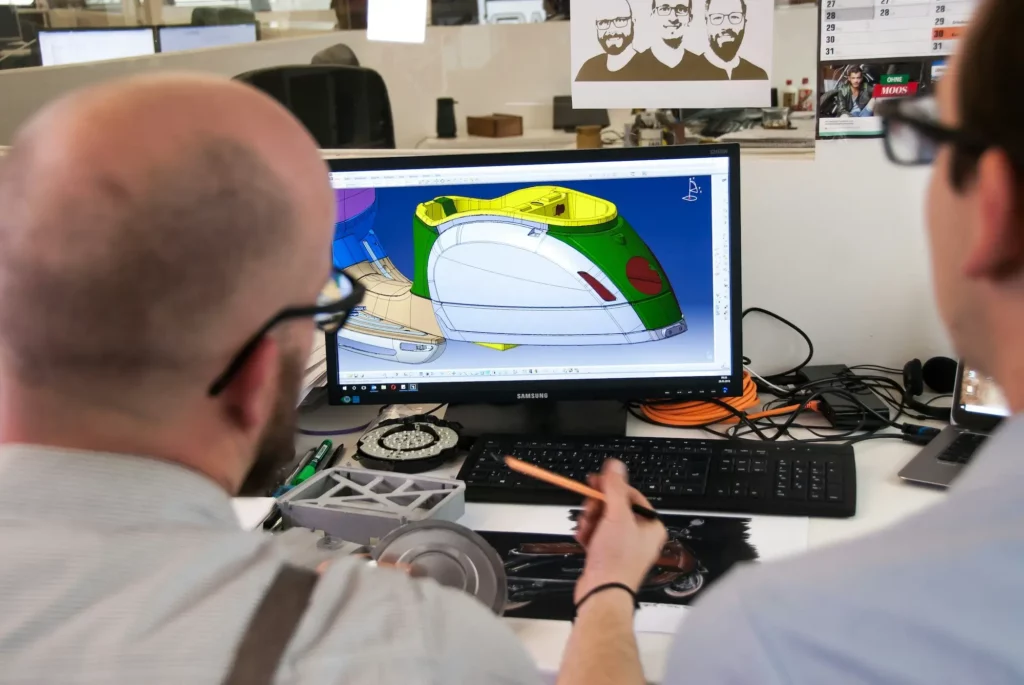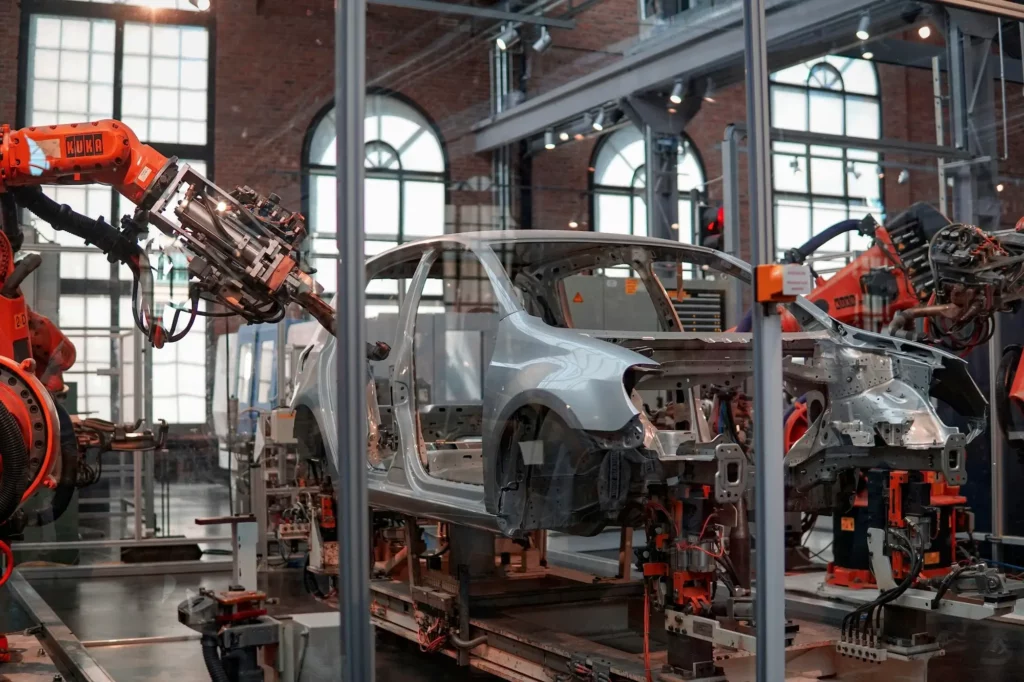Product teams often run into the same problems: unclear goals, rushed feedback, designs that are hard to build, or products that miss the mark with users. These issues slow everything down and lead to wasted time and effort.
To help avoid these common mistakes, here are 10 product design best practices your team should know.
What Is Product Design?
Product design is the process of creating a product that solves a real problem for users. It includes how something works, how it looks, and how it’s made. A good product design makes things easy to use, useful, and ready for real-world use.
It’s not just about drawing nice shapes or picking colors. Product design starts with learning what people need.
Then it brings together ideas, testing, and feedback to build something that works. This process often includes sketches, CAD files, 3D models, and prototypes.
Designers work closely with engineers, product managers, and other teams. They use tools to test ideas, review models, and fix issues before the product goes into production.
Avoid version mix-ups and keep engineering reviews organized with CADchat.
10 Product Design Best Practices You Should Try Out
Designing a great product takes more than just a good idea. Here are 10 simple best practices that can help your team build products that work well, look good, and meet real user needs.
1. Start With User Needs
Before you design anything, focus on the people who will use it. A product only works well if it solves a real problem. That’s why understanding user behaviors is so important.
Watch how people work. Listen to what they struggle with. You’ll start to see patterns and pain points that guide better design decisions.
A customer-centric mindset helps you stay on track. Don’t just guess what your users want. You can do a simple customer survey to know what they need.
This kind of thinking shapes the whole product. It helps you avoid waste and build something useful.
Always keep the target audience in mind. Their needs should lead every choice, from layout and features to how the final design looks and feels. Start here, and everything that follows will make more sense.
Brainstorm customer needs with your team effortlessly with CADchat. Try it now!
2. Focus on Business Goals and Market Fit
Good design starts with people, but it also has to make sense for the business. You’re not just building something cool.
You’re building something that helps the company grow. Product managers can help you connect what users need with what the business wants to achieve.
This is also where market research really helps. Look at what’s already out there. What are people using? More importantly, what are they missing?
A bit of market analysis can show you where the real opportunities are. That way, your team can focus on the most viable ideas that serve your intended audience while at the same time helping the business scale.
3. Get the Basic Functions Right
Looks matter, but function comes first. If a product doesn’t work well, users won’t care how nice it looks.
A strong user experience starts with function. People want products that are simple, clear, and easy to use.
Start by asking, what should this product do? Then design around that. Every part or feature should have a clear purpose.
Quality products are built on solid function. When something works the way people expect, it builds trust. They know they can rely on it. This matters whether you’re designing a tool, a machine part, or a full system.
Get the basics right, and everything else becomes easier.
4. Work With Engineers Closely
Great products are not made in silos. Designers and engineers need to work side by side from the start.
This is where cross-functional teams are truly beneficial. When the design team and engineering team work closely, things move faster, and there are fewer surprises down the line.
Engineers bring a different view. They understand how things are made, how parts fit, and how to avoid problems during production.
Designers focus on how the product feels and how people use it. When both sides share ideas early, you get a better product.
Using collaborative CAD software for mechanical engineers is one way to stay connected. It gives everyone a shared space to view models, spot issues, and suggest updates.
The design team can see how choices affect structure. Engineers can flag things that might not work in the real world.
This back-and-forth makes the process smoother. You avoid last-minute changes and save time. You build something that looks good, works well, and can actually be made.
Working together like this is not just helpful, it’s necessary.
Let engineers review designs anytime, from anywhere. Contact us to get started!
5. Build and Present a Rough Prototype
Once you understand the problem and talk with your team, start building a rough prototype. Don’t wait until everything is perfect.
A quick, simple version helps you test ideas early and get feedback fast. This is part of an iterative process. You build, test, learn, and improve, and then you do it again.
A rough prototype is not about looking pretty. It is about showing how something might work. It gives your team and stakeholders something real to react to. This makes feedback more useful. People understand better when they can see and try something.
Use design review software to share your work and collect feedback. These tools help everyone stay on the same page, especially if your team works in different places. You can leave comments, track changes, and fix issues without long back-and-forth meetings.
6. Consider Materials and Manufacturing
Before you go too far with your design, stop and think about how it will actually be made. The best ideas can fall apart if they are too hard or too expensive to produce.
This is where material choices and manufacturing methods come in. If you skip this step early on, you risk investing time in a design that will not work in the real world.
Use tools that support CAD collaboration to make this easier. Engineers and designers can work together in the same file, spot issues early, and make fast changes. It also helps teams stay aligned on technical limits, like wall thickness, part strength, or how parts will fit during assembly.
You should also plan a 3D model review with your suppliers. They know their materials best, and they can point out things in your design that might cause problems or raise costs.
Sharing models early gives suppliers time to ask questions and flag any risks. It also builds trust. They see that you value their input, and that leads to better results down the line.
Run your next design review inside the CAD model, not your inbox. Get started with CADchat.
7. Design for Durability
A great product design lasts. It should hold up over time, even with daily use. If something breaks too quickly, people will not trust it or buy from you again. That is why durability matters just as much as looks or features.
When you design for durability, you choose strong materials, simple parts, and smart connections.
You think about how the product will be used, dropped, moved, or stored. You also think about where it will be used. Will it face heat, cold, water, or dirt? All of this affects how long it will last.
Designing this way takes a bit more effort early on, but it saves time and money later. It also shows that you care about quality.
8. Keep the Design Simple
Yes, complex designs with shiny new features may look cool, but simple designs are often the best.
They are easier to build, easier to use, and easier to fix. When things get too complex, they slow people down. That is why it helps to keep only the design elements that truly matter.
Start by asking, what does the user really need? Remove anything that does not support that goal. Every part, shape, or feature should have a clear reason to exist. If it adds confusion or clutter, leave it out.
Simple design also makes testing and updates faster. You can spot problems more easily and make changes without reworking everything. It is easier for teams to work together when the product is clear and easy to understand.
This does not mean boring. You can still make something that looks good and feels right. But every choice should be intentional.
By focusing on the right design elements and avoiding extra noise, you build products that people enjoy using.
9. Use a Design Feedback Tool to Stay Aligned
When you’re working with a team, feedback is key. But long email threads or unclear comments can slow everything down. That’s where design feedback tools come in. They help your team share feedback in one place, right on the design.
Instead of guessing what someone means, you can leave comments directly on the model or drawing.
Everyone sees the same thing and can reply, ask questions, or suggest changes in real time. This works well for both the design team and engineers, especially when working on CAD files or 3D models.
These collaborative tools also help you track updates. You can see which version you’re working on, what’s been changed, and what’s still open. This makes the review process faster and easier to manage.
It’s also helpful when working with people outside your team. You can invite suppliers, clients, or other teams to view the design and leave feedback. No need to send files back and forth.
One tool for feedback, comments, and collaboration. Start using CADchat now!
10. Consider the Full Lifecycle
Designing a successful product is not just about how it looks or works today. It is also about how it will be used, maintained, and eventually replaced. Thinking about the full lifecycle is one of the most useful product design principles you can follow.
Start by asking simple questions. How will users take care of the product? Can parts be cleaned, fixed, or replaced? What happens when the product breaks or wears out? These answers shape your design in ways that help users and reduce waste.
You should also think about the end of the product’s life. Can it be taken apart easily? Are the materials recyclable?
You create products that last longer, work better, and are easier to manage after they leave your hands. That is better for users, for your team, and for the planet.
How CADchat Makes Product Design Way Easier
CADchat is a meeting platform built for product teams who work with CAD files.
It lets engineers, designers, manufacturers, and even non-technical teammates meet, talk, and give feedback right on the 3D model.
Everyone Works in the Same Space
Designing a product involves lots of people. Engineers, designers, and even folks from sales all need to stay in the loop. The problem is, they don’t always use the same tools.
CADchat fixes that. It gives everyone a shared place to view and talk about CAD files.
No More Screen Sharing
With CADchat, you don’t have to show your screen or send files back and forth. Just open the model in your browser. Your team can look at it together in real time.
It’s quick, simple, and easy to follow.
Feedback Happens Fast
Want to give real-time feedback? Just leave a comment right on the model. You don’t have to wait for the next meeting or write a long email.
Your team can check it and reply when they’re ready.
Easy for Non-Technical Teammates
Not everyone on a product team uses CAD tools, and that’s completely fine. CADchat is made so that anyone can join the conversation, even if they don’t have a technical background.
Executives, marketers, and other team members can open the model right in their browser, see what’s going on, and add their thoughts. They don’t need to install anything or learn how to use complex software.
Works Across Time Zones
When your team is spread out in different places, it can be tough to find a good time for meetings.
CADchat makes that easier by letting people leave comments, ask questions, or give feedback whenever it works for them.
You don’t need to wait for a live call or deal with long email chains. Instead, you can go into the model, see what others have said, and reply right there.
Everything is saved in one space, so you never miss a note or update.
Ready to Make Product Design Easier? Get Started with CADchat
If you’re tired of long email chains, confusing file versions, or meetings where half the team can’t follow along, CADchat is for you. It gives your team one simple place to meet, review CAD models, and share feedback, without needing extra tools or technical know-how.
Whether you’re in design, engineering, manufacturing, or marketing, you can join the conversation and help move things forward.
Cut review time in half with real-time CAD feedback. Contact us to start your CADchat journey today!
FAQs About Product Design Best Practices
What are the 4 C’s of product design?
The 4 C’s of product design are customer, cost, convenience, and communication. These help UX designers, engineers, and product teams stay focused on user needs, business goals, and market trends while building something useful and easy to use.
They guide teams working on balancing user expectations and the overall product development process.
What are the 5 elements of the product design process?
The five elements of the product design process are user research, defining the problem, creating user personas, building early versions, and testing with real users.
These steps help teams spot user problems, explore possible solutions, and make design decisions based on usability testing, user feedback, and valuable insights from actual needs.
What are the 7 basic principles of design?
The 7 basic design principles are balance, contrast, emphasis, rhythm, unity, proportion, and space.
These help designers create products that are not just functional but also visually appealing. They also guide visual elements and help maintain consistency across a design system.
What are the 4 key elements of product design?
The four key elements of product design are functionality, aesthetics, usability, and user-centered design.
These shape how good design supports business objectives, meets customer needs, and delivers user satisfaction.
They are central to product design best practices in the software industry and support continuous improvement through cross-functional collaboration.


